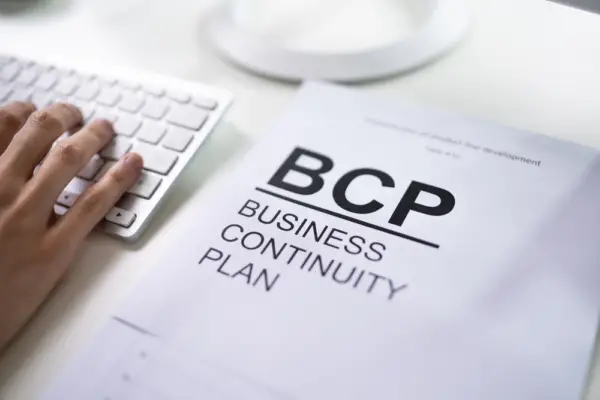A Business Continuity Plan for a construction company should be tailored to address the unique risks and challenges faced by the industry, such as site accidents, supply chain disruptions, equipment failure, and weather-related stoppages.
Here’s an outline of key elements that a construction company’s BCP should include:
- Introduction and Purpose: A brief description of the BCP’s objectives, scope, and key principles tailored to the construction industry’s needs.
- Business Impact Analysis (BIA): Identification of critical projects and processes, assessment of the potential impact of various disruptions on construction operations, and prioritization of recovery efforts.
- Risk Assessment: Analysis of specific risks relevant to construction, such as delays due to weather, labor shortages, or material unavailability, and the likelihood and impact of these events.
- Continuity Strategies: Strategies to maintain business operations, which might include diversifying suppliers, pre-qualifying subcontractors, or investing in weather-resistant materials and equipment.
- Incident Response Plan: Detailed response procedures for different types of incidents, including site accidents, supply chain issues, or natural disasters.
- Disaster Recovery Plan: Steps to recover critical functions and return to normal operations, such as reconstructing damaged structures or sourcing materials after a supply chain disruption.
- Organizational Roles and Responsibilities: Clearly defined roles for crisis management, including a chain of command and contact information for key personnel.
- Communication Plan: Protocols for internal and external communication, including with clients, subcontractors, and authorities.
- Employee Training: Regular training for employees on BCP procedures, emergency response actions, and safety measures.
- Plan Testing and Maintenance: Schedule for regular testing of the BCP to identify gaps, along with a process for updating the plan based on lessons learned, changes in operations, or new threats.
- Resource Management: Inventory of resources such as equipment, materials, and personnel, and how they will be managed during a disruption.
- Appendices: Supporting documents such as site maps, supplier contacts, backup site locations, and any other relevant information.
For construction companies, it’s important to have a BCP that is dynamic and adaptable to the often-changing conditions of construction projects. Regular updates and training can ensure that the plan remains effective.
In the fast-paced and unpredictable world of construction, having a robust Business Continuity Plan (BCP) is essential for maintaining operational resilience and minimizing potential disruptions.

From unforeseen natural disasters to supply chain interruptions, construction companies face unique challenges that require careful planning and preparedness.
In this discussion, we will explore the importance of a BCP in the construction industry, delve into the key components that should be included, and highlight the critical role of risk assessment, communication protocols, and continuous improvement.
By examining these aspects, we will gain insight into how a well-crafted BCP can safeguard a construction company’s operations and ensure its long-term success.
Key Takeaways
- Importance of BCP in construction: risk management, operational resilience, emergency response, and financial continuity.
- Risk management strategies: identify and mitigate threats, conduct comprehensive analysis, develop mitigation measures and recovery plans.
- Operational resilience measures: prioritize staff preparedness, leverage technology, address safety concerns, implement industry-specific solutions.
- Emergency response and communication protocols: develop incident response plans, use BCP templates, involve recovery teams, establish stakeholder communication channels.
Importance of BCP in Construction
The importance of a Business Continuity Plan (BCP) in the construction industry cannot be overstated. Risk management strategies are crucial in identifying and mitigating potential threats that could disrupt construction projects.
Operational resilience measures ensure that construction companies can adapt and recover quickly from unforeseen events, minimizing downtime and financial losses.
Additionally, having well-defined emergency response protocols in place enhances the safety of construction workers and helps maintain business continuity in the face of emergencies.
Risk Management Strategies
Implementing effective risk management strategies is crucial in the construction industry to ensure the continuity and resilience of operations, making the Business Continuity Plan (BCP) an integral component for construction companies.
- Identify potential risks and vulnerabilities in the construction company.
- Conduct a comprehensive business impact analysis to assess the potential impact of these risks on the company’s operations.
- Develop and implement risk mitigation measures to reduce the likelihood and severity of a disaster.
- Prepare recovery plans and allocate resources to effectively respond to and recover from an emergency situation.
Operational Resilience Measures
To ensure the operational resilience of a construction company, it is essential to prioritize the implementation of a robust Business Continuity Plan (BCP).
This plan should address various aspects, including staff preparedness, emergency response protocols, and disaster recovery plans.
For construction companies, having a BCP is crucial as it helps mitigate the impact of emergencies, such as a pandemic or natural disaster, on staff, equipment, and customers.
Leveraging technology and implementing solutions tailored to the construction industry further enhances the effectiveness of the BCP.
Emergency Response Protocols
Effective emergency response protocols are crucial for ensuring the success of a Business Continuity Plan (BCP) in the construction industry. To establish robust emergency response protocols, construction companies should consider the following essential steps:
- Develop an incident response plan that outlines specific actions to be taken during emergencies.
- Establish clear communication protocols to ensure effective coordination and information sharing.
- Use a business continuity plan template to guide the creation of a backup plan.
- Implement business continuity strategies that prioritize critical business processes and involve designated business recovery teams.
Key Components of a BCP
Key components of a Business Continuity Plan (BCP) include:
- Risk assessment strategies.
- Communication protocols.
- Recovery plan implementation.
- Training and testing.
These components are crucial for ensuring the resilience and continuity of a construction company in the face of unforeseen events or disruptions.
Risk Assessment Strategies
One crucial aspect of developing a comprehensive Business Continuity Plan (BCP) for a construction company is the implementation of robust risk assessment strategies.
These strategies help identify and evaluate potential threats and unforeseen events that could disrupt business operations.
In the business continuity planning process, risk assessment strategies play a vital role in determining recovery time objectives and addressing supply chain issues.
They also aid in the creation of effective business continuity templates and a backup disaster recovery plan.

Communication Protocols
To ensure seamless communication during unexpected disruptions, a construction company’s Business Continuity Plan (BCP) should include well-defined communication protocols. These protocols should outline the procedures for communication in the event of an incident or emergency response.
The BCP should designate a business continuity team and a crisis management team responsible for communication with employees and key staff. A communication plan should be established, outlining the communication channels and strategies to be used during a crisis.
Recovery Plan Implementation
The successful implementation of a recovery plan is crucial for a construction company’s Business Continuity Plan (BCP) to effectively mitigate the impact of disruptions and ensure the resumption of operations. This involves several key components:
- Assessing potential impacts: Identify the potential risks and impacts of unexpected events such as power outages or facility damages on the construction business and its processes.
- Allocating resources: Ensure the availability of necessary resources, such as protective equipment and backup power, to support recovery efforts.
- Activating response protocols: Establish clear protocols and communication channels to coordinate the response and recovery activities.
- Training and preparing employees: Provide training and awareness programs to equip employees with the necessary knowledge and skills to respond effectively during a disruption.
Training and Testing
During the implementation of a Business Continuity Plan (BCP), training and testing play vital roles in ensuring the preparedness and effectiveness of a construction company’s response and recovery efforts.
Training sessions should be conducted regularly to educate employees on the BCP and their respective roles during a disaster or emergency.
Drills, simulation exercises, and tabletop exercises should also be organized to test the company’s action plan and identify any weaknesses or areas for improvement.
This proactive approach ensures that the construction company is well-prepared to handle any unforeseen events and minimize potential disruptions.
Risk Assessment and Mitigation Strategies
When developing a business continuity plan for a construction company, it is crucial to identify potential risks that could disrupt operations.
By conducting a comprehensive risk assessment, the company can determine the likelihood and impact of each risk.
Once the risks are identified, appropriate mitigation plans can be developed and implemented to minimize their impact on the business.
Identify Potential Risks
To effectively ensure business continuity, a construction company must begin by conducting a comprehensive risk assessment and developing appropriate mitigation strategies.
The following potential risks should be considered when creating a business continuity plan:
- Natural disasters and extreme weather events that could disrupt construction projects and operations.
- Major disasters such as fires or explosions that may cause significant damage to property and equipment.
- Power outages or equipment failures that could halt construction activities.
- Staff absenteeism due to illness, accidents, or other unforeseen circumstances, impacting project timelines and productivity.
Additionally, potential risks related to the company’s accounting software should also be identified and addressed.
Develop Mitigation Plans
Developing effective mitigation plans is crucial for a construction company to ensure business continuity in the face of potential risks and disruptions.
To achieve this, the business owner and senior management must take the necessary steps to identify and assess potential risks, both internal and external, that can impact their operations and services.
Implement Risk Controls
To ensure the effective implementation of risk controls in a construction company, it is essential for the business owner and senior management to develop comprehensive strategies for risk assessment and mitigation. This involves identifying potential risks and implementing measures to minimize their impact.
Here are four key steps to implement risk controls:
- Develop an emergency plan to address unanticipated events or catastrophic events.
- Identify and train key employees to handle emergencies and ensure business continuity.
- Establish backup sites or alternative locations to minimize disruptions.
- Implement robust technology systems to protect critical data and ensure smooth operations.
Communication Protocols and Stakeholder Engagement
Effective communication and stakeholder engagement are crucial for the success of any construction company’s business continuity plan. Stakeholder communication channels need to be established to ensure timely and transparent information sharing.
Implementing an engagement strategy that includes regular updates, feedback mechanisms, and collaboration opportunities will help build trust and ensure that all stakeholders are involved and informed throughout the continuity planning process.
Stakeholder Communication Channels
The establishment of clear and efficient stakeholder communication channels is crucial for the successful implementation of a business continuity plan within a construction company. To ensure effective communication, the following steps should be taken:
- Identify and establish primary communication channels with stakeholders, including employees, clients, and suppliers.
- Develop protocols for regular communication during normal business operations.
- Establish emergency communication channels for immediate response when a disaster strikes.
- Coordinate with external resources such as emergency responders and business partners to enhance communication capabilities.
Engagement Strategy Implementation
Implementing an effective engagement strategy is essential for ensuring successful communication protocols and stakeholder engagement within a construction company’s business continuity plan.
Business leaders should follow basic steps such as conducting drill exercises, simulation exercises, and tabletop exercises to test the operational business continuity plan.
By doing so, they can identify any gaps or weaknesses in the plan and make necessary improvements. Additionally, incorporating facility management into the engagement strategy can offer benefits such as improved maintenance and cost optimization.
| Exercise Type | Purpose | Benefits |
|---|---|---|
| Drill Exercise | Test specific components of the plan | Identify weaknesses and improve |
| Simulation Exercise | Simulate real-life scenarios | Evaluate response and make adjustments |
| Tabletop Exercise | Discuss and review the plan | Enhance understanding and coordination |
Testing and Continuous Improvement
To ensure the effectiveness of a business continuity plan, testing methods need to be implemented to assess its performance and identify any weaknesses.
This can include tabletop exercises, simulations, and live drills to simulate potential disruptions and evaluate the response of the plan.
Additionally, continuous improvement strategies should be in place to address any identified gaps and enhance the plan’s capabilities over time.
Proactive analysis of incidents, lessons learned, and feedback from stakeholders can inform these improvement efforts and contribute to the overall resilience of the construction company.
Testing Methods
Effective testing methods are crucial for ensuring the success and continuous improvement of a business continuity plan for a construction company. To achieve this, the following strategies can be employed:
- Use specialized software to simulate potential threats and test the plan’s effectiveness.
- Conduct regular testing within a specific time frame to identify weaknesses and areas for improvement.
- Involve all relevant business units in the testing process to ensure comprehensive coverage.
- Take prompt actions to address any potential issues identified during testing.
Improvement Strategies
One key aspect of ensuring the success and continuous improvement of a business continuity plan for a construction company is by implementing strategies for testing and continuous improvement.
These improvement strategies are essential to maintain a reliable plan that can effectively handle disruptions and ensure the continuity of normal business processes.
Construction companies can benefit from testing their plan by simulating different scenarios and identifying any weaknesses or areas for improvement.
Additionally, having alternate resources, such as a technology recovery team and backup power supplies, can further enhance the plan’s effectiveness.
To determine the criticalness of essential services, construction companies can use a services criticalness factor template.
Frequently Asked Questions
What Are the Common Challenges Faced by Construction Companies in Implementing a Business Continuity Plan (Bcp)?
Implementing a business continuity plan (BCP) in construction companies can be challenging due to factors such as complex project timelines, reliance on external suppliers, and potential disruptions from natural disasters or unforeseen events.
How Does a BCP Address the Specific Risks and Vulnerabilities Unique to the Construction Industry?
A business continuity plan (BCP) addresses the specific risks and vulnerabilities unique to the construction industry by identifying potential disruptions, implementing preventive measures, and establishing protocols for response and recovery, ensuring minimal downtime and maximum resilience.
What Role Do Subcontractors and Suppliers Play in the Development and Implementation of a BCP for a Construction Company?
Subcontractors and suppliers play a crucial role in the development and implementation of a business continuity plan for a construction company. Their involvement ensures coordinated response efforts and minimizes disruptions to project timelines and overall business operations.
How Can a Construction Company Ensure Effective Communication and Coordination With External Stakeholders, Such as Government Agencies and Regulatory Bodies, During a Crisis Situation?
Effective communication and coordination with external stakeholders, including government agencies and regulatory bodies, during a crisis situation is crucial for a construction company.
This can be achieved through regular updates, clear communication channels, and adherence to regulatory requirements.
What Are Some Best Practices for Regularly Testing and Updating a BCP to Ensure Its Effectiveness and Adaptability to Changing Circumstances in the Construction Industry?
Regular testing and updating of a Business Continuity Plan (BCP) is crucial to ensure its effectiveness and adaptability to changing circumstances in the construction industry.
Best practices include conducting regular drills, incorporating lessons learned, and staying informed about industry trends and regulations.

Conclusion
In conclusion, a business continuity plan is crucial for construction companies to ensure the smooth operation of their projects and minimize the impact of potential disruptions.
By identifying risks, implementing mitigation strategies, establishing effective communication protocols, and regularly testing and improving the plan, construction companies can safeguard their operations and maintain stakeholder engagement.
It is imperative for construction companies to prioritize the development and implementation of a robust business continuity plan to enhance their resilience and ability to adapt in challenging circumstances.

Chris Ekai is a Risk Management expert with over 10 years of experience in the field. He has a Master’s(MSc) degree in Risk Management from University of Portsmouth and is a CPA and Finance professional. He currently works as a Content Manager at Risk Publishing, writing about Enterprise Risk Management, Business Continuity Management and Project Management.


